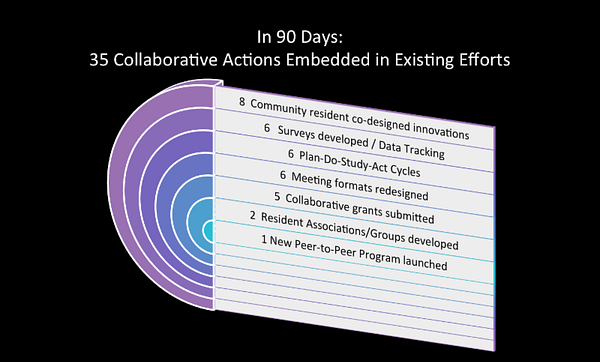The Real 90 Day Challenge: Building a Stronger Foundation for Ongoing Collaboration
On October 21st and 22nd we hosted a 2-day leadership summit attended by over 75 community residents, practitioners, advocates, educators, and service providers. The toolkit for this leadership and learning process was facilitated by the Institute for Healthcare Improvement (IHI) and the Interaction Institute for Social Change (IISC) and aided our network in establishing a common foundation for improvement work to promote child, family and community wellbeing.
Immediately following the summit the 90-Day Challenge was launched, where partners set their own aims and took action within our learning community.
All too often we host a major leadership event or training and then hope for the best. This time we wanted to learn more: What did our partners aspire to do and why did they attend the summit? What happened over 90 days? We talked with summit participants about ther hopes, challenges, and experiences. Participants reported an average of 2–3 new partnerships. One third modified their meeting structure based on content from the summit, which maximizes efficiency and focus on the desired outcomes. Over 53% of participants shared tools and skills from the summit with another group of people, increasing the learning network and common space for improvement work. The majority also participated in the online groupsite to extend in-person collaboration. Many partners changed how they did things, and identified issues with process.
Reflecting on our first large scale 90 day challenge, we are learning how community-driven solutions and co-designed innovations emerge when there is common ground: shared frameworks and tools and a network of partnerships and resources that foster stronger alignment and collaborative opportunities.
To date we have documented 35 Collaborative Actions taken during the 90 Day Challenge that have enhanced existing efforts to promote child, family, and community well-being. These actions fall into 5 primary categories:
- Building community capacity: sharing the toolkit and and strategies from the summit with other groups. (over 53%!)
- Connecting and Empowering Caregivers: using the facilitative leadership tools to assist with developing collaborations and group facilitation to develop peer-to-peer programs.
- Resident Engagement in Co-Design: using tools to support authentic decision-making in co-design processes.
- Reducing Barriers to Collaboration: using the online community to reduce barriers to healthy exchange of ideas
- Action-based Strategic Planning: using the toolkit to set an aim, and to learn by doing with network support for essential partnerships

As we prepare to launch the next 90-Day improvement cycle on March 9th we invite you to join us as a participant, learner, change agent, collaborator, or connector. Let's continue to challenge ourselves to work together in a new way and build a stronger foundation for ongoing collaboration to improve child, family, and community wellbeing.

